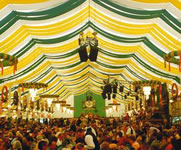These are already two of the 13 German wine growing regions of Rheinhessen, Palatinate, Baden, Mosel-Saar-Ruwer, Württemberg, Franconia, Nahe, Rheingau, Mittelrhein, Ahr, Hessische Bergstraße, Saale-Unstrut and Saxony: Mosel, Saar and Ruwer in the west with tangy Riesling and Müller-Thurgau, the Elbe in the east with Rivaner and delicately fruity Weißburgunder and Grauburgunder.
Wining & Dining
- A beer? We can offer you 5000!
- Freshness in abundance - German fish
- Potatoes, Selma and Sieglinde - the apples that grow in the soil
- Water - as pure as our unspoilt nature
- Germany - a paradise for sausage lovers
- 300 Types of Bread - and all of them healthy
- Wine & Dine-with German wine
- Schnapps - a heavenly treat
- The first course is a feast for the eyes
- Germany's Top 10 Food Museums
Germany for...
Wine & Dine - with German wine
These are already two of the 13 German wine growing regions of Rheinhessen, Palatinate, Baden, Mosel-Saar-Ruwer, Württemberg, Franconia, Nahe, Rheingau, Mittelrhein, Ahr, Hessische Bergstraße, Saale-Unstrut and Saxony: Mosel, Saar and Ruwer in the west with tangy Riesling and Müller-Thurgau, the Elbe in the east with Rivaner and delicately fruity Weißburgunder and Grauburgunder.
Additionally red wine is cultivated between Landau and Mainz. Mainly smooth Portugieser but powerful Dornfelder as well. The volcanic and slate soil of the northern part of the Ahr region mainly yields the fruity Spätburgunder.
But in general: three quarters of the German wines are white wines.
Travel Planner
Select an option...



